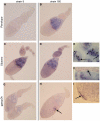Expression of Drosophila virilis retroelements and role of small RNAs in their intrastrain transposition
- PMID: 21779346
- PMCID: PMC3136932
- DOI: 10.1371/journal.pone.0021883
Expression of Drosophila virilis retroelements and role of small RNAs in their intrastrain transposition
Abstract
Transposition of two retroelements (Ulysses and Penelope) mobilized in the course of hybrid dysgenesis in Drosophila virilis has been investigated by in situ hybridization on polytene chromosomes in two D. virilis strains of different cytotypes routinely used to get dysgenic progeny. The analysis has been repeatedly performed over the last two decades, and has revealed transpositions of Penelope in one of the strains, while, in the other strain, the LTR-containing element Ulysses was found to be transpositionally active. The gypsy retroelement, which has been previously shown to be transpositionally inactive in D. virilis strains, was also included in the analysis. Whole mount is situ hybridization with the ovaries revealed different subcellular distribution of the transposable elements transcripts in the strains studied. Ulysses transpositions occur only in the strain where antisense piRNAs homologous to this TE are virtually absent and the ping-pong amplification loop apparently does not take place. On the other hand small RNAs homologous to Penelope found in the other strain, belong predominantly to the siRNA category (21nt), and consist of sense and antisense species observed in approximately equal proportion. The number of Penelope copies in the latter strain has significantly increased during the last decades, probably because Penelope-derived siRNAs are not maternally inherited, while the low level of Penelope-piRNAs, which are faithfully transmitted from mother to the embryo, is not sufficient to silence this element completely. Therefore, we speculate that intrastrain transposition of the three retroelements studied is controlled predominantly at the post-transcriptional level.
Conflict of interest statement
Figures





Similar articles
-
Evolution and dynamics of small RNA response to a retroelement invasion in Drosophila.Mol Biol Evol. 2013 Feb;30(2):397-408. doi: 10.1093/molbev/mss241. Epub 2012 Oct 18. Mol Biol Evol. 2013. PMID: 23079419
-
[The unusual mobile element Penelope and its behavior in distant Drosophila species].Genetika. 2003 Feb;39(2):269-79. Genetika. 2003. PMID: 12669424 Russian.
-
The structure and evolution of Penelope in the virilis species group of Drosophila: an ancient lineage of retroelements.J Mol Evol. 2001 May;52(5):445-56. doi: 10.1007/s002390010174. J Mol Evol. 2001. PMID: 11443348
-
Penelope-like elements--a new class of retroelements: distribution, function and possible evolutionary significance.Cytogenet Genome Res. 2005;110(1-4):510-21. doi: 10.1159/000084984. Cytogenet Genome Res. 2005. PMID: 16093704 Review.
-
Genomic regulation of transposable elements in Drosophila.Curr Opin Genet Dev. 1995 Dec;5(6):768-73. doi: 10.1016/0959-437x(95)80009-t. Curr Opin Genet Dev. 1995. PMID: 8745075 Review.
Cited by
-
piRNAs Are Associated with Diverse Transgenerational Effects on Gene and Transposon Expression in a Hybrid Dysgenic Syndrome of D. virilis.PLoS Genet. 2015 Aug 4;11(8):e1005332. doi: 10.1371/journal.pgen.1005332. eCollection 2015 Aug. PLoS Genet. 2015. PMID: 26241928 Free PMC article.
-
sRNA-FISH: versatile fluorescent in situ detection of small RNAs in plants.Plant J. 2019 Apr;98(2):359-369. doi: 10.1111/tpj.14210. Epub 2019 Feb 12. Plant J. 2019. PMID: 30577085 Free PMC article.
-
Spontaneous gain of susceptibility suggests a novel mechanism of resistance to hybrid dysgenesis in Drosophila virilis.PLoS Genet. 2018 May 29;14(5):e1007400. doi: 10.1371/journal.pgen.1007400. eCollection 2018 May. PLoS Genet. 2018. PMID: 29813067 Free PMC article.
-
FASTmiR: an RNA-based sensor for in vitro quantification and live-cell localization of small RNAs.Nucleic Acids Res. 2017 Aug 21;45(14):e130. doi: 10.1093/nar/gkx504. Nucleic Acids Res. 2017. PMID: 28586459 Free PMC article.
-
Recurrent and recent selective sweeps in the piRNA pathway.Evolution. 2013 Apr;67(4):1081-90. doi: 10.1111/evo.12011. Epub 2013 Jan 17. Evolution. 2013. PMID: 23550757 Free PMC article.
References
-
- Kazazian HH., Jr Mobile elements: drivers of genome evolution. Science. 2004;303:1626–1632. - PubMed
Publication types
MeSH terms
Substances
LinkOut - more resources
Full Text Sources
Molecular Biology Databases

